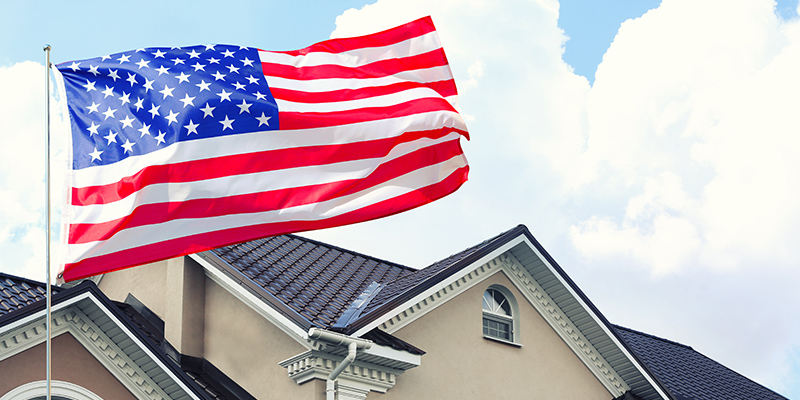Can Homeowners Be Asked To Remove American Flag In HOA Communities?
If homeowners have been asked to remove the American flag in HOA communities, trouble can follow. For homeowners associations, it is important to act with caution when it comes to flag rules, especially on appropriate holidays.
Can the Board Ask to Remove the American Flag in HOA Communities?
There is no denying the importance of military service in the United States. In fact, it is so important that there are specific days dedicated to celebrating those who have served or are currently serving in the United States Armed Forces. Military personnel and veterans have fought and continue to fight for the nation’s freedom. And one of the ways Americans can show their support is to fly the U.S. flag.
Some Americans display the U.S. flag only on certain holidays, such as Veterans Day, Memorial Day, or the Fourth of July. And then there are others who choose to display the flag all 365 days of the year. But, whether it is a Veterans Day flag or a year-round flag, many homeowners get slapped with a violation letter from their HOA. The letter almost always includes an order to remove the display or face a fine for each day the flag remains up.
When this happens, homeowners understandably feel angered or frustrated. Is flying the American flag really something that warrants a fine from the association? Can homeowners associations even prevent residents from displaying Old Glory?
While HOAs generally have the power to enact and enforce rules, these rules must always be consistent with federal and state laws. Outright prohibiting homeowners from flying the American flag would be in breach of the Freedom to Display the American Flag Act of 2005. However, this does not automatically mean HOAs have no authority to ask an owner to remove the flag. It really depends on the variables at play.
The Freedom to Display the American Flag Act of 2005
 The American Flag Act specifically regulates homeowners associations, condominiums, and cooperatives. According to this Act, HOAs “may not adopt or enforce any policy, or enter into any agreement, that would restrict or prevent an association member from displaying the U.S. flag on residential property within the association with respect to which such member has a separate ownership interest or a right to exclusive possession or use.”
The American Flag Act specifically regulates homeowners associations, condominiums, and cooperatives. According to this Act, HOAs “may not adopt or enforce any policy, or enter into any agreement, that would restrict or prevent an association member from displaying the U.S. flag on residential property within the association with respect to which such member has a separate ownership interest or a right to exclusive possession or use.”
But, the Act also goes on to say that the display of the American flag must be done in a proper manner (consistent with the U.S. Flag Code). Moreover, the Act gives HOAs the ability to enforce reasonable restrictions on the time, place, and manner of display, provided these restrictions are necessary to protect property values.
Proper Display of the Flag
If a homeowner wishes to display the American flag, they must do so in a manner consistent with the U.S. Flag Code. While the Flag Code contains several provisions, some of the most important ones include:
- Display the flag only from sunrise to sunset on buildings and stationary flagstaffs in the open. If an owner wants to display the flag 24 hours a day, they must ensure to properly illuminate the flag in the dark.
- The flag must never touch anything below it nor touch the ground.
- Owners must hoist the flag briskly and lower it ceremoniously.
- The flag must be free of any drawings, markings, or insignia.
- Owners must take the flag indoors during inclement weather unless they are using an all-weather flag.
- On Memorial Day, owners should fly the flag at half-mast until noon to honor fallen military veterans. After that, they must raise it to the top of the staff.
It is worth noting that the Flag Code encourages owners to fly the U.S. flag on all days but especially on special days such as:
- Veterans Day
- Memorial Day
- Constitution Day
- Armed Forces Day
- Labor Day
- Flag Day
- Inauguration Day
- Thanksgiving Day
- Christmas Day
- And more!
Reasonable Restrictions Allowed
The Freedom to Display the American Flag Act of 2005 allows HOAs to place reasonable restrictions. Reasonable restrictions are those that help protect the character and interest of the association as well as the property values within the community.
Common restrictions include restricting the height of flag poles, the placement of flag poles, and the architectural style of the flag poles. Many associations also require owners to seek approval from the HOA board or the architectural review committee before displaying the American flag. The general objective of such a process is to make sure that the location and manner of flag placement align with both the community’s guidelines and the U.S. Flag Code.
If the governing documents permit, associations can also charge fines to owners who violate the flag rules of the community. The exact dollar amount of such fines can vary from one association to another. That being said, it is normal for HOAs to fine owners for each day the flag display remains in violation of the rules.
Advice for Homeowners Associations
 When it comes to flag rules, HOA boards should act carefully because there is a lot of room for liability. In fact, several lawsuits have emerged from this very dispute — from Florida and Texas to Ohio and Kansas. And the last thing any HOA wants is to deal with expensive lawsuits. There’s also the backlash that comes with being featured in headline news.
When it comes to flag rules, HOA boards should act carefully because there is a lot of room for liability. In fact, several lawsuits have emerged from this very dispute — from Florida and Texas to Ohio and Kansas. And the last thing any HOA wants is to deal with expensive lawsuits. There’s also the backlash that comes with being featured in headline news.
Boards should keep in mind that they cannot prohibit homeowners from flying the U.S. flag. While reasonable restrictions are allowed, it is not easy to come up with rules that follow federal and state laws while simultaneously keeping a tight rein on architectural standards. As such, it is always best to seek the help of a lawyer to draft the community’s flag rules.
Once an HOA has completed its flag rules, it is imperative to communicate these rules to all homeowners. This way, everyone knows what they can and can’t do. It is also a good idea to re-distribute these rules right before patriotic holidays to remind owners and help minimize violations.
When In Doubt
Displaying the U.S. flag is one of the simplest yet meaningful ways to show patriotism. Homeowners associations should, therefore, tread cautiously when it comes to enacting and enforcing flag rules. When in doubt, it is best not to ask homeowners to remove the American flag in HOA communities, unless the display is clearly in violation of the Flag Code and the HOA’s lawful flag rules.
RELATED ARTICLES:
- Condo Decorations Rules: Fair And Unfair Policies
- Memorial Day VS Veterans Day: What’s The Difference?
- HOA Holiday Planning: How To Prepare For The Holidays




 Once a violation has occurred, the association’s response typically begins with written notice. This notice of violation will contain the details of the infraction. Normally, homeowners will have the opportunity to correct the violation without further consequence, especially if it is their first violation. However, depending on state laws and the governing documents, some HOAs do proceed with
Once a violation has occurred, the association’s response typically begins with written notice. This notice of violation will contain the details of the infraction. Normally, homeowners will have the opportunity to correct the violation without further consequence, especially if it is their first violation. However, depending on state laws and the governing documents, some HOAs do proceed with 
